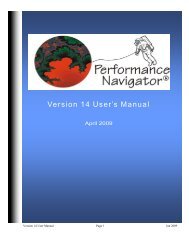Version 15.1 User’s Manual
Version 15.1 User's Manual - Midrange Performance Group
Version 15.1 User's Manual - Midrange Performance Group
Create successful ePaper yourself
Turn your PDF publications into a flip-book with our unique Google optimized e-Paper software.
Capacity Planning<br />
In this section, our goal is to understanding the components of Trend Analysis, including:<br />
<br />
<br />
Understanding the components of the “What IF” Modeling screen<br />
Understanding the methodology to properly capacity plan<br />
In this section, we will learn how to capacity plan our systems for the future. That is, by learning<br />
the What IF modeling techniques, we can accurately predict future hardware and software<br />
needs.<br />
Capacity Planning Rule #1<br />
Before we begin this chapter, we all have to remember the golden rule of capacity planning. It<br />
is:<br />
Capacity Planning is not an exact science …<br />
But I had a great plan …<br />
That is, even when the most structured capacity planning processes are put into place, sometimes what<br />
was predicted doesn’t come true. In other words, the system you predicted you would need may have<br />
been too big or too small.<br />
For the new capacity planners out there … Welcome to the crazy world of capacity<br />
planning, where the gray hair on your head is not going to be the result of a<br />
bad golf game. Here is an example of what could happen in the real world:<br />
Management gives you the following task. Ensure our current systems will work<br />
with the following business factors:<br />
<br />
<br />
Business predicted growth 12% a year<br />
To support a strategic new application<br />
You apply the methodology that has worked for years, and the following year,<br />
your predicted system didn’t quite cut it. Why? You find out that:<br />
The new application was bigger than expected<br />
A second application was needed to support the business (that no one told you about)<br />
The company business grew 25%<br />
The company bought another company and its related workload<br />
That’s why capacity planning is not an exact science. As structured as your processes are, sometimes<br />
you’re modeling criteria changes. That’s why the goal of this chapter is to create a Capacity Planning<br />
methodology that will make your jobs easier. The goal is being able to build supporting documentation<br />
for capacity planning projects. If your predictions held true, you’re a genius. If they didn’t, you now<br />
have supporting documentation to show how you came to your conclusions.<br />
In the next section, we will start with understanding the What IF Modeling screen.<br />
<strong>Version</strong> 15 User <strong>Manual</strong> Page 148 Oct 2011




